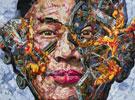Nirvana
-On the Art of Qu Qianmei
Tao Yongbai
On entering the casting galleries, I was shocked by the immense, grave and tragic atmosphere of Qu Qianmei’s works. It felt as if I was observing a deathly stillness and immense disaster following a catastrophic event, as if I had heard a dull thunder-like symphony surging from the underground. What a huge suffering presented itself before my eyes. It stirred at my soul and the core of my being. It was impossible to relate this pretty woman with a soft accent in front of me to such a background! The works of such an elegant woman are actually so daring and imposing, and she handles such grand epic-like massive works. What kind of woman is she?
Qu Qianmei is like a woman that has walked out of the Nanxi River in Wenzhou. She was born with a watery spirituality while her blood flowed with the pioneering DNA that dared her to go anywhere. Qu Qianmei has loved drawing since she was young, and in 1985 when she was nearly 30 years old she followed her dream and went to France for further study. Throughout her life, the god of destiny has always played games with her. She deviated from her original intention as she was living under pressure that was created by the business world abroad. On two occasions she was put in jail, though she unexpectedly held three art exhibitions. She has remarkable composure! During the 26 years of sojourn in France, she experienced the magnificence of a has-been, betrayal by close friends, marital breakdown and was jailed all at the same time. The dramatic ups and downs of life tempered a delicate woman from the region of a river and lakes into an experienced and tough individual that can withstand all eventualities. She carried the weight and burden on her thin shoulder with a straight back and patiently endured the pain and became fed up with cheating within the world of business. After prison, she began to regain her childhood dream though her mind was exhausted and she was able to hold 1.7 billion francs in her hands again and regain her artistic capability again.
Originally Qu Qianmei learned traditional Chinese painting, yet to express with great eloquence the nameless “inner needs”, she turned to the exploration of abstract art. In 2008, she returned to her motherland and the Central Academy of Fine Arts to commence further concentrated study in the specialty of art material while seeking new methods to express her art. She’d like to live following her own heart.
The secret god-like calls she heard and an accidental trip to Tibet were a revelation to her and opened her heart which in consequence inspired a flash of genius. The long road to the west had quietly become a pilgrim’s spiritual journey. Bathing under high mountains, fields of snow, a blue sky and white clouds, she felt cleansed of earthly troubles and pains so she felt a purity of her heart or what even be considered a baptism of her soul. While the sacred temples and the five-color waving flags placed her in a solemn atmosphere within Tibetan Buddhism, she also felt a visual sensitivity of religious majesty. The Tibetans who use their body to measure land and the piety expressed by the suffering of the flesh to redeem soul made the tide of her heart rise and fall, recalling the past, all of this seemed elusive from centuries ago.
She perceived of a place in the sky, which is the paradise of world’s most holy soul, also a holy land which activates the inspiration for art and potential art works that are buried deep in her heart.
Returning from the journey to the west, her creative inspiration flowed like a spring. The bitter state and depression that had accumulated over a long period of time having been influenced by the apprehension of life, all evolved into the works cumulated by the use of red kaolin – The Soul of Tibet-Environment · Encounter. The grand and majestic imposing manner, the desolate, gloomy and pathetic tones formed a ravishing symphony. The tension immediately stirs the heart which touches people so they sigh and exclaim!
Qu Qianmei’s works found a new sense by painting from the deep, bitter, rough, and primitive ecological environment, which knocked at her “inner sound”. Her works represent the affection in her innermost soul, the true temperament which allows her to do as she pleases without any regard to material gain, the conversion of mind or the martyrdom of art.
She applied integrated materials to recount her “thoughts”, and was a master-hand in utilizing materials. With her perception, she chose kaolin as a screen texture, hundreds of Jins of square iron pillar as frames, and rotten wood as devices, accompanied with coal epoxy, hemp rope, tea and other ecological materials. As art media, these pure natural materials from nature formed the artistic style of her works - plain, honest, rough, and majestic. Art creation is a creating process, once one masters the properties of materials and idiosyncrasies of objects, one might recreate the original natural forms of materials into new forms, thus it does not just enhance its visual vigor on an aesthetic dimension but eventually the materials also transform into the carrier, in a cultural sense, which possess spirituality.










